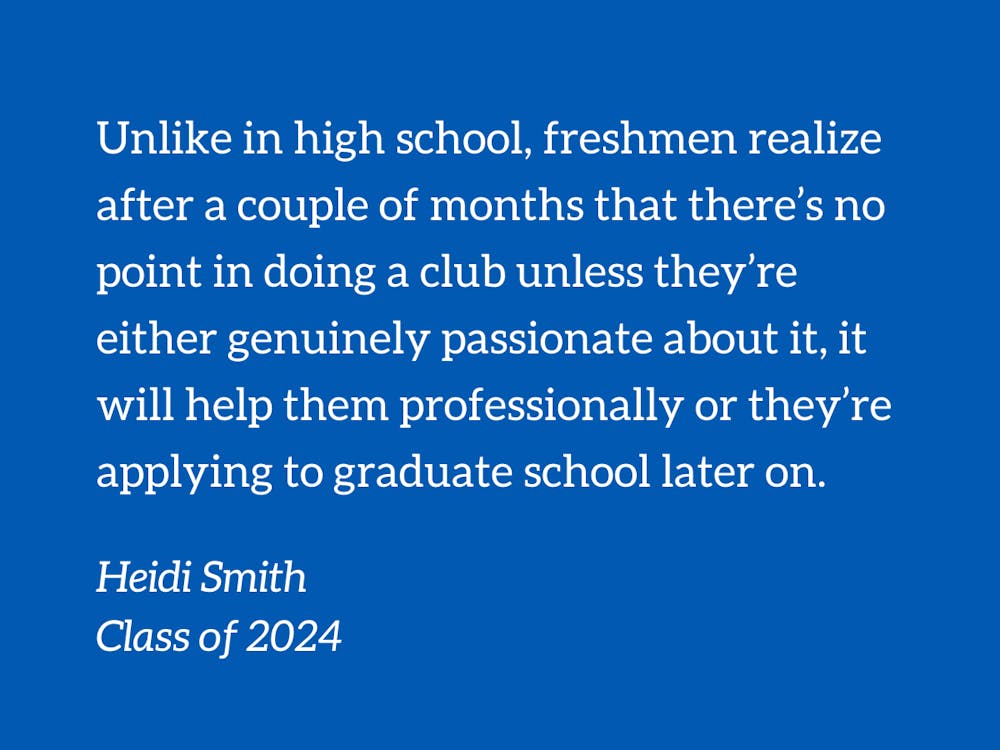As we reach the end of the school year, it has become time to prepare for the next one. As the current president of Rotaract Club, I recently sent our applications for the executive board to current active members. This request came with the understanding that, unless a minimum number of people apply, the club will likely cease to exist. Don’t worry—this isn’t an ad to join my club, but a means to talk about the frustrations that come with our extracurricular involvements here at large.
We often start the year strong with Rotaract; most of us did community service in high school, whether through Interact, Key Club or something else, and many freshmen are eager to get involved, or at least join the email list. While initial interest garners many potential members, at this point in the year, post-spring break, our general body attendance often hovers around one non-board member, if we’re lucky. It’s a bit frustrating, not to mention almost nonsensical, to plan events that effectively only our board attends—as well as embarrassing if we invite community members to speak or promise volunteers for a service endeavor.
It’s not that no one wants to do community service now that we don’t have to apply to college again—that’s a whole different issue. Duke students who are interested in service are further segmented into the mass of clubs here. We even have an umbrella organization, Duke Partnership for Service, to manage the dozens of service-related organizations on campus. And as largely non-selective, non-competitive organizations by nature, it seems we’ll all be competing with more groups for less funding, with the new DSG decision.
Membership isn’t an issue just for service organizations, either. If I talk to anyone who’s on the board of a club, it seems like they’re facing the problems of membership retention—especially for more niche-interest organizations—and/or engagement of the members they do have, even in the clubs that seem “too big to fail.” In many instances, becoming president or another high-level officer of one is more a matter of signing up than running. Even incentives of food and merch aren’t always working to get people to show up to things anymore.
We can’t really blame anyone but ourselves. We’re the ones who created the clubs and decide to maintain them. According to DukeGroups, there are 642 current clubs. Since two of the organizations I’m a part of are not on there, including the Chronicle, I’m assuming this actual number is a bit higher, though maybe a tour guide could provide me with the official stat. I’m not here to say which clubs should be dissolved or absorbed, but just that this is an unsustainable ratio for a school of our size.
We have just under 7,000 undergraduates here. Suppose everyone is in a club or two; that evens out to maybe 10 or 15 people per group. Maybe ten would be great for a book club, but it’s quite literally not enough to field a soccer team—nor run the Chron, for that matter. From my observations, we have a handful of clubs with very high membership or interest and a ton of others with relatively small general bodies. Some groups will naturally have higher interest than others, so even if overall the average membership numbers would seem to work, they just don’t in practice.
Students have limited bandwidth, and there’s no need to have ten Unique and Impactful activities to put on your Common App anymore. Unlike in high school, freshmen realize after a couple of months that there’s no point in doing a club unless they’re either genuinely passionate about it, it will help them professionally or they’re applying to graduate school later on.
Especially in my time in a service organization, it has become abundantly clear to me that Duke students won’t do anything that doesn’t help them in some way—and, sure, that purpose could just be making yourself feel better about how good of a person you are. We are a largely pre-professional, mid-size university. UNC has around 800 clubs, barely more than us, and yet they have almost 20,000 students. I’m no math major, but those numbers don’t seem to work out.
There are lots of clubs that do similar things, and many that have just an event or two every year. Might it be more manageable and, more importantly, more fun for everyone involved if we perhaps did some “mergers and acquisitions” to create larger, more sustainable clubs that serve broader purposes? It’s a lot more enjoyable to be in a group that other people want to be in too, and it’s no fun at all to try to revive one that’s struggling. A lot of not-fun bureaucracy comes with maintaining a student organization, which no one wants to handle. Maybe we should work towards minimizing the unfun bits and focus on what matters: coming together to do something you love with people who share that common interest.
Heidi Smith is a Trinity junior. Her column runs on alternate Mondays.
Get The Chronicle straight to your inbox
Signup for our weekly newsletter. Cancel at any time.

